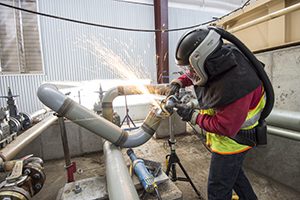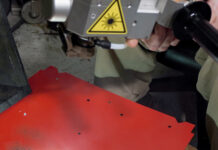Have all the razors suddenly gone dull?
Turns out autumn itself is the reason for the extra scruff. The start of hunting season inspires men nationwide to grow out their beards. Add to that Movember, when men grow facial hair throughout November to raise awareness of prostate and other cancers, and you have millions of men proudly showing off a more rugged look.
Men whose work requires use of a respirator may be forced to say bye-bye to the beard. And when facial hair is part of your identity; that rule stings worse than the nicks from an old razor.
A clean shave is required in a variety of industries for many respirators to work correctly. The good news? This isn’t true of all respirators. Some options are regulatory-compliant while protecting workers who prefer to keep facial hair.
But, protecting workers from airborne hazards requires more than simply handing out respirators and must be supported by a respiratory protection program. Following are suggestions on how to start your respiratory program or revisit an existing program.
Begin with an Assessment
Conducting a respiratory exposure assessment and utilizing the results to design an effective respiratory protection program for your team is a science. It can seem like a complicated science when you factor in everything that goes into developing and creating a respiratory protection program: initial review of potential hazards, measurements, evaluation of those measurements, selection of controls, their implementation and assessment of their effectiveness, and other factors.
Exposure Assessment
Employers are required by the US Occupational Safety and Health Administration (OSHA) to evaluate respiratory hazards in the workplace. At a high level the evaluation should identify:
- What hazards are present (e.g. welding fumes)
- Exposure levels
- Whether or not those levels are acceptable – compared to OSHA permissible exposure limits (PEL) or, if lower, other good practice occupational exposure limits (OEL)
Hazard Control Evaluation
If the assessment shows that exposure levels of airborne contaminants are outside of the OSHA limits, the respiratory protection program administrator should first see if the exposure can be controlled through engineering controls (e.g.. elimination, substitution, or local exhaust ventilation) or administrative controls (e.g. use of relief workers, rotation of workers or work breaks). If there is no way to effectively reduce the exposure to acceptable levels, respiratory protection must be provided.
 Exposure Assessment
Exposure Assessment
If the assessment shows that exposure levels of airborne contaminants are outside of the OSHA limits, the respiratory protection program administrator should first see if the exposure can be controlled through engineering controls (e.g.. elimination, substitution, or local exhaust ventilation) or administrative controls (e.g. use of relief workers, rotation of workers or work breaks). If there is no way to effectively reduce the exposure to acceptable levels, respiratory protection must be provided.
Respiratory Protection – Getting Started
US OSHA in 29 CFR 1910.134 details the requirements for a respiratory program. Employers who will be using respirators at their facility must read and understand these regulations. A written program is also required by OSHA and is a core component to an effective and complete respiratory protection program. Per 29 CFR 1910.134 the written program must address worksite-specific procedures for issues, such as:
- Respirator selection
- Medical evaluation of the wearer
- Fit testing
- Use of respirators in both routine and emergency situations
- Maintenance, cleaning, disposal and care of the respirators
- Assuring adequate air quality if supplied air respirators are used
- Training of the worker on the respiratory hazards they may encounter and the proper use, care and maintenance of the respirator they will use
- Program evaluation to ensure proper functioning
Respiratory Selection
After identifying the hazards, the exposure levels from the exposure assessment must be compared to the permissible exposure limit, or PEL, as set by OSHA, to determine if respiratory protection is needed. Occupational exposure limits (OEL), are good practice recommendations set by product manufacturers or other professional societies can also be considered if exposure levels are below the PEL.
Any respirator used in a U.S. workplace must be approved by the National Institute for Occupational Safety and Health (NIOSH). All NIOSH-approved respirators have an assigned protection factor (APF) ranging from 10 to 10,000. The APF is the workplace level of respiratory protection that a respirator or class of respirators is expected to provide to employees when a complete respiratory protection program is implemented. An APF of 10, for example, means that, when selected and used correctly, a particular class of respirators can reduce exposure levels that are up to 10 times the contaminant PEL to a level determined by OSHA to be acceptable.
Medical Evaluation and Fit Testing
Before wearing a respirator, workers need to be medically evaluated to help ensure they can safely wear the respirator. OSHA requires workers to first complete a questionnaire regarding health conditions that could affect their ability to wear a respirator, as well as the workplace conditions and hazards they face. A licensed healthcare professional then must evaluate the employee’s responses and advise whether the worker is able to wear the class of respirator being considered.
Fit-testing must be conducted annually or whenever a change occurs that may affect the fit (e.g. significant change of weight that affect the face, significant dental work, or change in model of facepiece). Refer to 29 CFR 1910.134 for more details.
Respirator Training
OSHA mandates that employers ensure that workers are trained annually. This provides a forum for users to become reacquainted with the importance of respiratory protection and to give everyone a refresher course in properly using and caring for their equipment.
Respiratory Maintenance
Respirators should be inspected before each use and during cleaning. Users must follow the manufacturer’s user instructions for specific inspection and maintenance procedures. Emergency respirators should be inspected at least monthly and before and after every use, and should commonly consider issues such as:
- Respiratory function
- Tightness and connection
- Pliability of elastomeric parts
- The condition of various parts including the face piece, head straps, valves, connecting tube, cartridges, canisters or filters.
Program Evaluation
All elements of a respiratory protection program should be evaluated regularly. The respiratory protection administrator should examine all records to make sure tests, training and inspections are up-to-date. They should also observe and talk to users of respiratory protection equipment to ensure respirators are meeting their needs and that workers understand and follow procedures for using and maintaining them. It is important to make a record of evaluations and findings, to note any deficiencies, and to document all necessary corrective measures. All of these observations and records help when updating a written respiratory protection program.
Managing an effective respiratory protection program not only keeps companies compliant with relevant regulations, but a well-run program also is the best way to help ensure that your workers are protected from respiratory hazards.
Still shaving due to current respirator restrictions? Learn more about respirators that are approved for use with limited facial hair and hear worker testimonials here.
About 3M
When it comes to fabricating, assembling or processing anything around the world, 3M knows efficiency is key. For you, for your team, and for your bottom line. From ultra-strong abrasives that keep processes running smoothly, to futuristic materials that literally lighten your workload. Their innovative solutions can keep your business and your employees working smoothly.
References:
(1) A Strategy for Assessing and Managing Occupational Exposures 4th ed. (2015) American Industrial Hygiene Association (www.aiha.org)
(2) 29 CFR 1910.134 – Respiratory Protection (www.osha.gov)




















